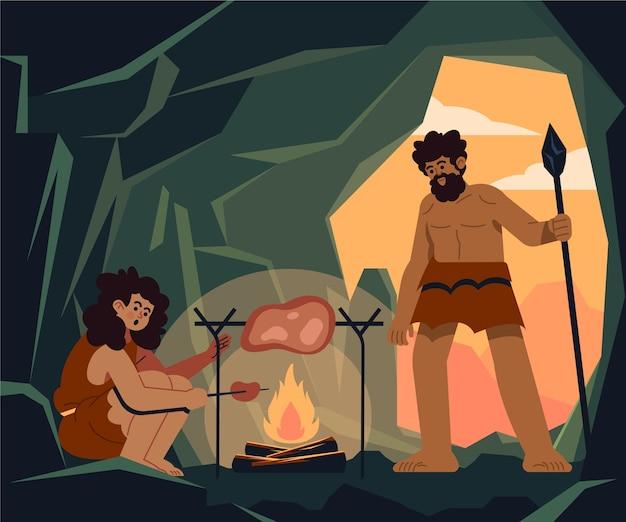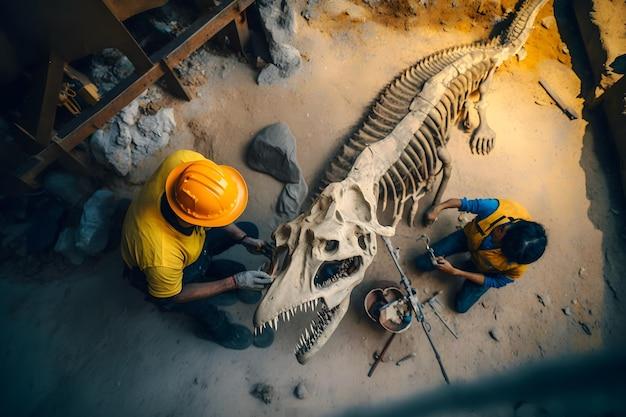Welcome to our blog post on the intriguing Paleolithic Age! In this article, we will explore the three main characteristics that defined this captivating era in human history. But before we delve into the nitty-gritty details, let’s set the stage with a brief overview.
The Paleolithic Age, often referred to as the Stone Age, is a period that spans from around 2.6 million years ago to about 10,000 years ago. It is one of the earliest known periods of human existence. The word “Paleolithic” translates to “old stone” in Greek, denoting the primary material used by ancient humans to fashion tools and weapons. This epoch witnessed remarkable advancements in human adaptation and survival strategies, paving the way for the future of civilization.
So, without further ado, let’s embark on a journey through time and discover the three main characteristics that shaped the Paleolithic Age!

The Three Key Features of the Paleolithic Age
The Hunter-Gatherer Lifestyle: Survival of the Fittest
In the Paleolithic Age, our early ancestors didn’t just sit back and wait for the latest Netflix series to drop—they were active hunters and gatherers, constantly on the move in search of food. They lived off the land, navigating through the diverse environments that Mother Nature had to offer. From the lush forests to the vast plains, our Paleolithic predecessors had to rely on their physical abilities to outwit and outrun their prey. And let’s not forget about the plants and fruits they gathered along the way. It was a true survival of the fittest scenario—only the most adaptable and resourceful individuals could thrive.
Innovative Tool Making: Where There’s a Will, There’s a Way
While our Paleolithic ancestors may not have had access to high-tech gadgets or the latest smartphone updates, they definitely knew how to improvise. One of the most remarkable characteristics of the Paleolithic Age was the development of tools. They crafted stone tools that became the Marc Jacobs bags of their time—essential for survival, a fashion statement in their own right (well, maybe not fashion, but definitely functional). These early humans transformed rocks into sharp-edged blades, creating weapons for hunting and tools for various purposes. They had drills, spearheads, scrapers, and even needles made from animal bones—imagine giving acupuncture to a woolly mammoth!
Cave Paintings: The Original Artistic Expression
Move over, Pablo Picasso and Vincent van Gogh—we’ve got some serious competition from the Paleolithic Age. These ancient artists took to the canvas (or should we say cave walls) and left a lasting mark on history. One of the captivating aspects of the Paleolithic Age is the discovery of cave paintings. These early ancestors didn’t have Instagram to post their travel photos, but they did have the artistic vision to create mesmerizing paintings in caves across the world. From the famous Lascaux caves in France to the Altamira cave in Spain, these stunning artworks depict animals, hunting scenes, and even shamanic rituals. Who needs a MoMA ticket when you can step into a time machine and admire the art of our prehistoric predecessors?
In summary
The Paleolithic Age was characterized by the hunter-gatherer lifestyle, innovative tool making, and awe-inspiring cave paintings. Our ancestors relied on their physical abilities, resourcefulness, and artistic expressions to navigate a world that was wildly different from the one we know today. So next time you’re hunting for your car keys or whipping up a masterpiece in your kitchen, remember the incredible accomplishments of our Paleolithic predecessors. And maybe take a moment to appreciate the wonders they left behind.

FAQ: What are the 3 main characteristics of Paleolithic Age
The Paleolithic Age, also known as the Old Stone Age, was a crucial period in human history. It laid the foundation for the development of civilizations and marked our transition from hunter-gatherer societies to settled communities. In this FAQ-style subsection, we’ll dive deeper into the Paleolithic Age and explore its key characteristics.
What is the meaning of Paleolithic Age
The Paleolithic Age, derived from the Greek words “paleo” meaning old and “lithos” meaning stone, refers to a prehistoric era where early humans relied on stone tools for survival. It spans a vast period from around 2.6 million years ago to approximately 10,000 BCE (Before Common Era). During this time, our ancestors began to exhibit behavior and tools that set them apart from earlier hominid species.
What are the three main characteristics of the Paleolithic Age
-
Hunter-Gatherer Lifestyle:
The Paleolithic Age was characterized by a nomadic lifestyle centered around hunting, gathering, and foraging. Early humans roamed in small bands, following migratory patterns of animals and seasonal availability of food. They relied on hunting animals, such as mammoths and reindeer, as well as gathering wild plants, fruits, nuts, and seeds for sustenance. -
Primitive Technology and Tools:
The Paleolithic Age witnessed the development and utilization of primitive tools made primarily from stone, bone, and wood. These tools were essential for survival, encompassing hand axes, spears, scrapers, and various types of blades. These implements were crafted through a process called knapping, in which stones were skillfully shaped and modified into functional tools. -
Cave Art and Early Symbolism:
A fascinating characteristic of the Paleolithic Age is the emergence of early artistic expression. This period saw the creation of cave paintings, carvings, and etchings, providing us with valuable insights into the daily lives, beliefs, and rituals of our ancient ancestors. These captivating artworks depicted scenes of hunting, wildlife, and abstract symbols, showcasing human creativity and the desire to communicate.
What is the difference between the Paleolithic and Neolithic Ages
The Paleolithic Age and the subsequent Neolithic Age mark two distinct phases in human history. While both were crucial for our development as a species, several key differences set them apart:
- The Paleolithic Age was characterized by a nomadic hunter-gatherer lifestyle, whereas the Neolithic Age witnessed the rise of settled agricultural communities.
- In the Paleolithic Age, humans relied on stone tools, while in the Neolithic Age, they gradually began to develop more advanced tools, including polished stone tools and pottery.
- The Paleolithic Age predates the Neolithic Age, spanning a much longer time period from approximately 2.6 million years ago to around 10,000 BCE. The Neolithic Age followed, lasting roughly from 10,000 BCE to 4,500 BCE.
What were the tools used in the Paleolithic Age
In the Paleolithic Age, early humans crafted a variety of tools, each serving a specific purpose. These tools included:
- Hand Axes: These handheld, symmetrical stone tools were used for cutting, chopping, and shaping various materials.
- Scrapers: Designed to remove flesh from animal hides, scrapers played a crucial role in early humans’ use of animal skins for clothing, protection, and shelter.
- Spears: Constructed using sharpened wooden shafts with stone tips, spears were vital for hunting and defense against predators.
- Blades: Blades, typically made of flint or other types of stone, were versatile cutting tools, used for tasks such as butchering, slicing, and scraping.
- Burins: These specialized tools had a chisel-like shape and were used for carving wood, bone, or antler.
Why is the Paleolithic Age important
The Paleolithic Age holds immense significance as it marks the earliest stages of human development and the foundations of our civilization. Understanding this era allows us to comprehend the incredible adaptability and ingenuity of our ancient ancestors in overcoming various challenges, such as hunting, gathering, and tool creation. Additionally, the Paleolithic Age provides valuable insights into the origins of human culture, art, and social interaction, paving the way for future advancements.
The Paleolithic Age, with its distinct characteristics of a hunter-gatherer lifestyle, primitive tools, and the emergence of cave art, forms a crucial part of our collective human heritage. By studying this era, we gain a deeper understanding of our roots and the remarkable journey that has led us to the modern world. So let’s marvel at the ingenuity of our ancient ancestors as we continue to explore the treasures of our past.
